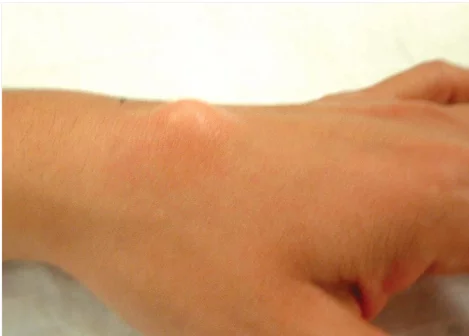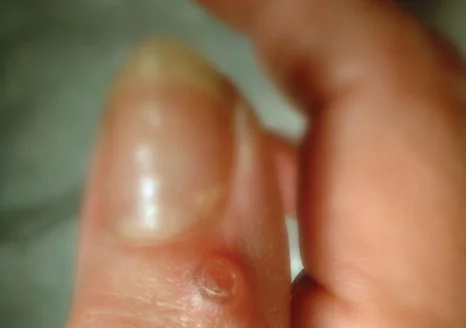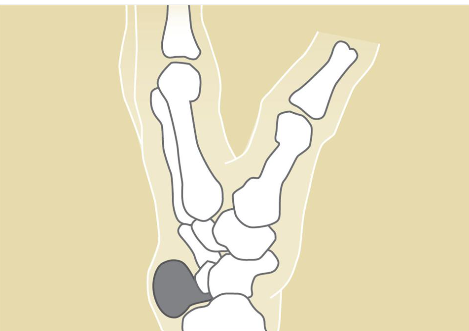What is a Ganglion Cyst?
A ganglion cyst is a lump at the hand and wrist that occurs near joints or tendons. It may be described as a mass, swelling, or bump. Ganglion cysts are common. They are frequently found in common locations and are often seen on the back of the wrist in the middle. They can also be near a finger joint. When they are on the palm of the wrist, they are typically off-center toward the base of the thumb (see Figure 1). They may also be felt at the base of the finger on the palm side. They are sometimes seen on the fingertip (near the end joint) on the back of the finger (see Figure 2).
The ganglion cyst may be filled with a clear, gel-like fluid. It can be thought of as a water balloon on a straw (see Figure 3). The straw is connected to a joint or tendon sheath. Joints and tendon sheaths normally produce fluid. This fluid production may cause the cyst to increase or decrease in size. Some cysts may disappear completely over time. A ganglion cyst is not cancerous and will not spread to other areas.

A ganglion cyst shown on the top side of the wrist

A ganglion cyst shown at the end joint of the finger, also known as a mucous cyst

Cross-section of wrist showing the root of the ganglion cyst
Causes
A ganglion cyst can occur in patients of all ages. While the cause of ganglion cysts is unknown, the cysts may form in the presence of joint or tendon irritation, arthritis, mechanical changes, or injury.
Signs and Symptoms
Your ganglion cyst may or may not be painful. The cysts are typically oval or round and may be soft or very firm. Cysts at the base of the finger on the palm side are typically very firm. They are often smaller than a pea and tender to pressure, such as when gripping something.
Cysts at the end of the finger just below the fingernail are often associated with arthritis. They are called mucous cysts. The chronic pressure from the cyst on the tissue that creates the fingernail can result in a nail depression or groove. This nail groove often goes away when the cyst is treated. The fingertip swelling can be confused with a wart or a nailfold infection. Consider seeing a hand surgeon if initial treatments for a fingertip lump do not seem to be working. With mucous cysts, the overlying skin may become stretched thin. This thin skin may break, causing the thick jelly-like fluid to come out. If this occurs, gently press in the area to get as much fluid out, clean the finger with soap and water, and cover the puncture site until it is fully sealed and healed after a few days. If this skin opening becomes red and painful, it may be infected. Because the skin hole communicates with the joint, it can rapidly destroy the cartilage of a joint. Because the joint may already have arthritis, it becomes urgent to receive treatment for the infection which may require both antibiotics and surgery to wash out the joint infection.
Diagnosing a Ganglion Cyst
The diagnosis is usually based on the location of the lump and its appearance. Light will often pass through these lumps, and this may assist in the diagnosis. Your hand surgeon may request x-rays in order to look for evidence of problems in adjacent joints. Other imaging tests such as ultrasound can be helpful to diagnose a ganglion cyst because the uniform dark appearance of the fluid in the cyst is often characteristic. They are also visible on MRI (magnetic resonance imaging), which is often helpful when the cyst is suspected but cannot be easily felt during the exam. Your doctor will also ask you questions about your medical history in diagnosing your problem.
Treatment
Non-Surgical
Treatment for a ganglion cyst can often be non-surgical. In many cases, these cysts can simply be observed, especially if they are painless. Ganglion cysts could disappear spontaneously. If the cyst becomes painful, limits activity, or is otherwise causing problems, several treatment options are available.
The different types of non-surgical treatment may include:
- Observation (doing nothing but keeping your doctor informed if things change)
Splints and anti-inflammatory medication, which can decrease pain associated with certain activities
Aspiration: This is done to remove fluid from the cyst and decompress it. This requires placing a needle into the cyst, which can be performed in most office settings. Sometimes the fluid is so thick it doesn’t fill the syringe. Pressure can be applied to the cyst to force the fluid out of the cyst into the surrounding tissue under the skin. Aspiration can be done with or without ultrasound guidance. Recurrence of the cyst is common since the cyst wall, or sac, and stalk remain connected to the joint.
Surgical
If non-surgical options fail to provide relief, or if the cyst reoccurs, surgical alternatives are available. Surgery involves removing the cyst wall, fluid, and stalk. It may include removal of a portion of the joint capsule or tendon sheath. In the case of wrist ganglion cysts, both open and arthroscopic techniques usually yield good results. Surgical treatment is generally successful. Even with surgery the cyst can come back since we do not fully understand what causes them and there are no known preventions. If the ganglion cyst returns and does not hurt, it can be left alone. If it returns and hurts, it can be removed again. Your orthopaedic hand surgeon will discuss the best treatment options for you and give medical advice specific to your condition.
To book an appointment, use our online scheduling tool or call our office at 707-273-3410.



